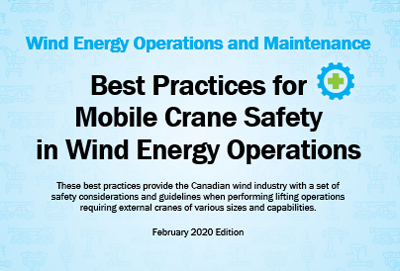CanWEA Best Practices for Mobile Crane Safety in Wind Energy Operations

Mar 24, 2020
By Phil McKay
Canada’s wind power operations and maintenance (O&M) leaders have generated another one-of-a-kind resource to set the bar for health and safety in the industry. Wind energy site staff and contracted technicians are responsible for identification and resolution of a wide range of worn or damaged equipment on a wind farm. Wind turbines are made up of many major components that endure harsh environments and constant operation. This can include blades, gearboxes, generators, motors, hydraulic equipment, transformers and other large equipment necessary to keep the machines generating clean power. The industry makes regular use of mobile cranes for component repairs and replacements at operational sites across the country. These activities can involve a crane service provider, third party technicians and project managers, full-time site staff and other specialists needed for the job.
The Best Practices for Mobile Crane Safety in Wind Energy Operations were developed by stakeholders from across disciplines to provide wind farm site staff with a set of guidelines for safe execution of mobile crane operations. The resource is aimed at equipping wind turbine technicians, site managers, health and safety specialists and directors with useful information to spur further development and collaboration in state-of-the-industry thinking.
The guide begins by setting some common definitions for the industry using existing standards and internal company policies. It also clearly defines the expectations from industry for the various roles required during a lift operation. Some of these roles include:
• Crane Operator
• Crane User
• Lift Supervisor
• Rigger
• Tag Line Operator
• Spotter
The guide then moves on to several considerations for the stages of a lift operation including; Pre-lift, Setup and During Work, and Demobilization. This part was developed through an iterative approach comparing internal policies and procedures with elements taken from each contributor to arrive at a true industry best practice.
Through the development process, it was identified that a collection of references to Canadian regulations and international resources would prove useful. In addition, a collection of pre-lift job briefings and checklists was created and merged to create an exhibit for direct application to job sites.
CanWEA is excited to offer this new resource to the industry and continue the advancement of safe site practices. The O&M Caucus is already considering what to tackle next to make Canada’s wind fleet even more productive.
Visit the O&M Health and Safety page for this and more resources and to find out how you can get involved in future projects.
Phil McKay is Operations and Maintenance Program Director at the Canadian Wind Energy Association
Source: https://canwea.ca/operations-and-maintenance/health-and-safety/




![Guide to the Canadian Electrical Code, Part 1[i] – A Road Map: Section 52 — Diagnostic imaging installations](https://electricalindustry.ca/wp-content/uploads/2022/11/Guide-CE-Code-2-768x432.png)





![Guide to the Canadian Electrical Code, Part 1[i] – A Road Map: Section 52 — Diagnostic imaging installations](https://electricalindustry.ca/wp-content/uploads/2022/11/Guide-CE-Code-2.png)






